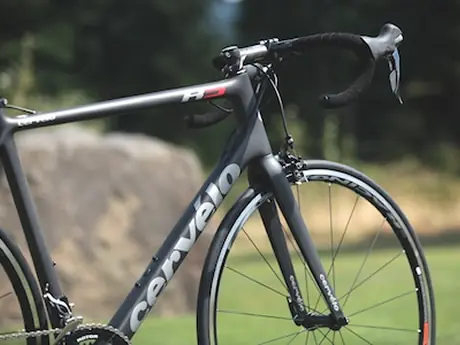
Several months ago, I had the opportunity to test ride the fully California-made and heavily lusted after Cervelo RCA. The limited-run model is an exercise in wretched excess; exotic materials, proprietary queues and handbuilt in America at a small manufacturing plant in Southern California. And at $10,000 for a frame, it was the dream bike that was always going to remain for many of us just that; a dream.
Just ahead of Eurobike, Cervelo debuted the new R5. And you'll be forgiven if, on first glance, you mistake it for the RCA. If so, mission accomplished by the Canadian company; this new, Asia-produced model takes the learnings from the California, produces it at a greatly decreased cost in Asia and puts it on store showroom floors, at a comparative pittance.
More: Trek Debuts Redesigned Speed Concept Bike
Indeed, there are sacrifices that help bring costs down. The first is the absence of the 3M Nanovate application on the fork steerer. This nano-tech application created a level of strength and durability to the steerer—with much less weight—that added to the safety of the steerer/stem interface, which exists as a major area of high fatigue and impact stress.
Cervelo reinforced the carbon steer with, well, more carbon in the R5 to meet the exceptionally high steerer impact and fatigue metrics Cervelo sets for itself. Also gone from the R5 is the use of some exotic (and very expensive) proprietary carbon fiber cloth that was used sporadically and focally in the bottom bracket area on the California model.
During development of the RCA, and as one would expect, the R5, there was a side benefit engineers discovered: aerodynamics. Engineers worked and reworked the Squoval3 shape in all the main tubesets and especially in the downtube, particularly with its lopped trailing edge. And as seen on the California, Cervelo engineers rotated the whip-thin seatstays into an ovalized shape that runs now as a thinner aero profile. Cervelo puts the aero advantage over its predecessor R5 at 7.4 watts at 50 kilometers per hour.
More: Gear Review: Easton EC90 Aero 55 Wheels
While ride quality was paramount when developing the RCA and by default, the R5, aerodynamics were an unintentional finding. And of all companies, who was Cervelo to give aerodynamics back? In fact they pursued its benefits.
"It's like what we have on our website; what's the tipping point?' Cervelo co-founder Phil White told LAVA on site during its unveiling to the media recently. "When do you give up aero for weight? That was the goal with the California; to build aerodynamics into a bike without sacrificing weight. We met all our parameters in dropping weight and keeping stiffness—and then we made it more aero. We're a bike company that prides ourselves in aerodynamics, so it's important to us here."
- 1
- of
- 2









Discuss This Article